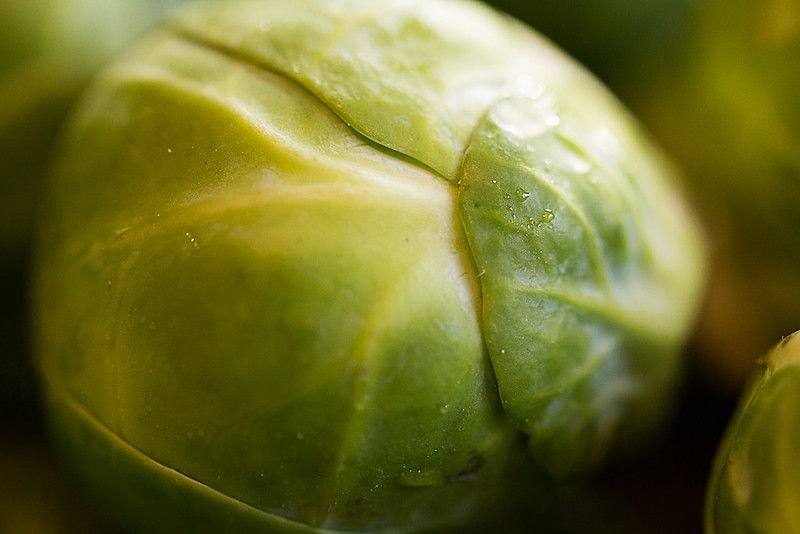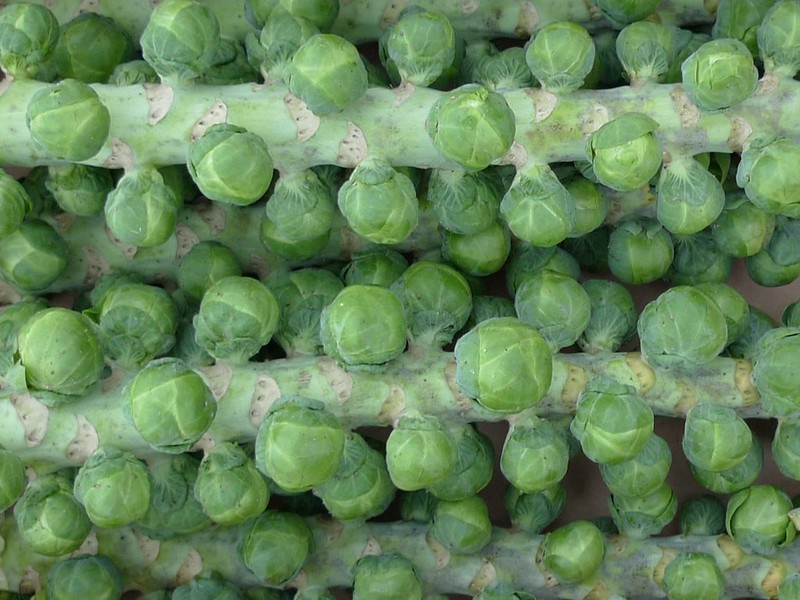December Eat the Seasons: Brussels Sprouts
I feel like sprouts are going through a bit of a renaissance. Nowadays, everyone wants a piece of them! When I was a kid, saying you liked Brussels Sprouts would make you as unpopular as saying you didn’t like football. They were infamous.

Posted on Mon 21 Dec 2020 · by Oliver Haenlein
I’m sure this had something to do with the 20th century British obsession with boiling the hell out of everything. Brussels don’t take kindly to being overcooked by boiling; they smell bad and taste bitter. They like being blanched, sure, fried, steamed or roasted; even eaten raw. And I think today’s home cooks get that, and have come up with hundreds of great ways to enjoy beautiful, sweet, nutty sprouts.
Their name hails, unsurprisingly from their cultivation in Belgium, near Brussels, in the 13th century. They obviously feel super Christmassy, so are a great pick for December. They are a cold-season crop and thrive in cooler climates. Mini cabbage-like buds grow along thick, straight stalks, which can be over a metre long. Sprouts are a great mid-winter veg because even if they are ready earlier, harvesting can be delayed as they withstand the cold temperatures well - in fact it is often said they are sweeter and tastier if picked after being exposed to a frost!
What to look out for when buying?
It can be a fun Christmas ritual to buy them still on the stalk. Either way, look for freshness by choosing sprouts that are still really firm and green with outer leaves that haven’t discoloured excessively. You can even look at where the sprouts were cut from the stalk, and if that section is really dry and old looking you know they’ve been harvested a while ago, sat around losing flavour.
Prepping Your Sprouts
If still on the stalk, cut them off, trimming any excess stem. The stem is a lot harder then the leafy part, so when it comes to cooking, if there’s too much of it then the rest of the sprout will be overcooked by the time the stem has become tender enough to eat. The same goes for buying loose sprouts - get rid of any excess stem. Peel off any loose or discoloured outer leaves. Simply cutting them in half will help them cook evenly. If you want to blanch them whole, it is also a good idea to cut a little cross in the base where the stem is, to help the heat penetrate this tougher part.

Why are they good for you?
Friend of CED and guest nutritionist Emily Moreton (Insta: thenutrinurse) gives us the low down:
Brussels sprouts are low in calories yet high in nutrients. They contain high amounts of fibre, great for your gut and cardiovascular health. They are high in iron, manganese, phosphorus, Vitamin A, Vitamin C, Vitamin K, all of the B vitamins, and in particular are a great source of folic acid which is important in early pregnancy. Sprouts get a bad rep due to their gaseous properties. They can be slightly more difficult to digest due to a complex sugar called raffinose. Our digestive system doesn’t produce a huge amount of the enzyme that we use to break down raffinose. It isn’t just sprouts though, the same goes for all of the brassica family.
Some of the nutrients do decrease as a result of cooking but it is minimal, and they still hold significant nutritional value once cooked. If you did want to hold on to the nutrients you could consume them raw, shredded in a salad. Or you could shred some unwanted raw sprouts and then freeze and add them when needed to dishes such as stir-fry's, omelettes and frittatas for an extra nutrient punch.
What do they go with?
All around the world there are great dishes combining cabbage with pork, they're the best of mates. You'll find the combo in Chinese stir-fries, Italian winter soups, German sauerkraut and sausages...the list goes on. Sprouts definitely bring strong cabbage flavours so we can use the same approach. This is why there are so many sprouts recipes with bacon. In our special recipe below we have put them together with Speck! The sweet smokiness of chestnuts pairs well too, while harnessing a festive energy that comes with both these ingredients. Nuts in general bounce nicely off the slightly bitter notes in sprouts, hazelnuts or pine nuts are great. A little sweetness or sharpness also goes beautifully - mixed with some tangy citrus or cooked with vinegar.
What did you say?
As we always do with Eat the Seasons, we asked our Instagram following their favourite way to cook sprouts. The most popular response was the roasting method. Put them in a hot oven and watch something magical happen! They come out dark, sweet, nutty and delicious. One shout was to roast them with some balsamic vinegar in the tray - sounds great! A number of you said you liked to prepare them with bacon, others cook them together with herbs, peas and leeks. That rich and distinctive sweetness that comes with sweated down leeks is a perfect match, and one we've used for our tart recipe below. You told us to use them instead of cabbage for a slaw - great for keeping all the nutrients in them as Emily suggested above. A more leftfield suggestion was to prepare them with pomegranate, maple syrup and hazelnuts, which we'd love to try!
Recipe Time: Our Brussels Sprouts Recipe for Eat the Seasons

Brussels Sprouts Tart with Leeks, Speck and Gruyere Cheese
So you've probably never seen sprouts put in a tart before, but trust me this is delicious! We use crisp shortcrust pastry and mix a little cream and eggs in with the main filling ingredients so it just sets in the oven.
The sweated down leeks are a must, but the Speck and Gruyere can be substituted for other similar ingredients. Gruyere is so good in this recipe, but you could use another tangy cow's cheese like Comte, Emmental or even mature Cheddar. Speck is a smoky cured ham from Alto Adige in the far north of Italy, where it borders with Austria. You can find it in most larger supermarkets, however you could instead use pancetta or even bacon. If you use either of these, throw them in the pan in step 3 with the leeks as they need cooking off, unlike the Speck.
We've put ready-rolled pastry in the ingredients list; feel free to make your own but we don't want to discourage people from making the recipe by making it too complex.
You may well find yourself with excess sprouts this festive season, this is your perfect use-up recipe!
Serves 4-6
- 1 Sheet Shortcrust Pastry, large enough to fill a 20-25cm tart case
- Around 30 Brussels Sprouts, trimmed and halved
- 2 tbsp Extra-Virgin Olive Oil
- 2 Large Leeks, thinly sliced
- 2 Garlic Cloves, thinly sliced
- 2 tbsp Fresh Thyme Leaves
- Around 100g Speck slices, torn into small pieces (see paragraph above for alternatives)
- 80g Gruyere Cheese (see paragraph above for alternatives)
- 30g Parmesan Cheese
- 2 Eggs, lightly whisked
- 150ml Single Cream
- Cut a circle of pre-rolled shortcrust pastry large enough to cover the base and sides of your 20-25 cm tart case. The circle will need to be a good few centimetres larger than the tart case base all the way round so that it will also line the sides. Too much is better than too little - you can always trim it if you have excess. Line the tart case with the pastry and then put baking beans into the pastry case. We just use a few sheets of clingfilm over the pastry, then fill with rice or lentils. Cook in the oven at 180C for around 20 minutes, until the sides are starting to brown. Remove the baking beans and cook for another 5 mins to dry out the base a little.
- Meanwhile, blanche the halved sprouts in salted boiling water for 4-5 mins, until just tender. Drain and cool with cold water to stop the cooking. Set aside.
- In a frying pan, sweat down the leeks on a medium-high heat with the oil, thyme, garlic and a good pinch of salt. After around 10-15 minutes they will be soft and reduced, with no liquid in the pan. Remove from the heat.
- After the leek mix has cooled a little, in a large bowl or in the pan if it's spacious enough, mix in the cooked sprouts, speck, the cheeses, cream and eggs. Season with salt and pepper and mix well. Fill the blind-baked pastry case with the mixture. Sprinkle with a little more fresh thyme. Bake in the oven at 200C for around 25 mins, until golden brown on top. If the pastry looks like it's going to burn at any point, turn the oven down to 180C. Once cooked, allow to cool down a little for 5-10 minutes, slice and serve!
